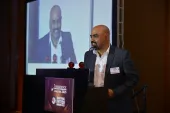
Insurers embrace digitalisation, embedding to meet evolving customer expectations – KPMG leaders
KPMG Singapore’s Steven Goh and Frank Dubois noted that insurers must proactively communicate with customers to explain several factors impacting their policies and premiums.
The insurance industry is a complex and ever-changing landscape, and the experts at KPMG Singapore have spent decades navigating it. Frank Dubois and Steven Goh, two of KPMG's leading voices in the sector, have a wealth of experience between them.
Frank Dubois has been with KPMG since 1997 and joined KPMG Singapore in 2010, where he established the Insurance and Actuarial Practice. He is now the Singapore Head of Insurance. Working closely with Frank is Steven Goh, a Financial Services Audit Partner with over 25 years of sector audit experience across the APAC countries. He is currently the Head of Insurance Audit at KPMG Singapore.
Both of them have played crucial roles in building up the insurance sector capabilities at KPMG Singapore by leading numerous projects related to advisory in accounting, actuarial and regulations; restructuring and transformation; and more recently, ESG.
The two KPMG leaders highlighted that insurers today are expected to react to customers' rapidly evolving expectations by transforming their digital servicing capabilities. The profound digital transformation across the insurance industry led to the rapid adoption of AI-based claims assessment tools, parametric underwriting, and RPAs to deliver efficiency at a lower cost to consumers whilst enhancing user experience (UX).
Embedded insurance radically transforms how insurance providers interact with customers in their daily commute, payments, and other digital transactions seamlessly; integrating scalable UX and expanding their customer base and reducing the insurance coverage gap in underserved Asian markets.
In this interview, we will delve deeper into their insights and experiences in the insurance industry and learn more about their role in shaping the sector's future.
The continued global inflation is expected to impact the insurance industry’s value chain and ramp up claims costs. How can insurers prepare for this? What strategies can they employ?
Rising inflation will have a significant impact on the insurance industry’s value chain and claims costs. The claims cost in question includes both the costs incidental to the insured loss, for example, the costs of replacement of insured assets, medical expenditures, and also claims management expenses, either handled in-house or with third-party administrators.
Insurers can prepare for inflation in several ways across the value chain (e.g., claims, underwriting, investments, and risk management), including:
- Strengthening claims management processes: Insurers can strengthen their claims management processes to prepare for handling an increase in claims costs due to inflation. This may involve investing in technology to improve claims processing efficiency, implementing cost containment measures, and collaborating with ecosystem providers (e.g., healthcare providers, garage networks, etc.) to manage costs.
- Reviewing underwriting practices and pricing: Insurers may also benefit from a review of their underwriting practices and pricing policies to be appropriate considering the inflationary environment taking advantage of the current soft markets. Some of the interventions may involve one or more of the following actions: adjusting premiums, setting appropriate deductibles, and tightening underwriting standards to mitigate risk.
- Re-evaluating investment strategies: Insurers may also need to reevaluate their investment strategies to ensure they are well-positioned to withstand inflationary pressures. This may involve shifting investments into inflation-resistant assets such as real estate, commodities, and inflation-protected securities.
- Augmenting risk management capabilities: Insurers can enhance their risk management capabilities to identify and mitigate potential inflation-related risks. This can involve conducting stress tests to assess the impact of inflation on their portfolios and developing contingency plans to mitigate any negative impacts. The insurance industry in Singapore is sufficiently capitalised to ride through the short to mid-term adverse impact of inflation on its bottom line.
Whilst gearing up for combating inflation, it is important that insurers are simultaneously communicating with customers on these initiatives and why these are needed to be in place now more than ever. Insurers need to proactively communicate with their customers to explain how inflation may impact their policies and premiums. This will help the insurers to pre-empt and manage customer expectations/reactions and mitigate any potential adverse consumer reaction arising from the interventions put in place to counter the inflationary environment.
What are your thoughts on the overall performance of Asia’s insurance industry for the past year? Are there trends or challenges insurers can take note of?
- Growth and Operating efficiency: In Asia, the focus is still on driving insurance penetration to close the protection gap that exists in this market. Increased technology adoption to reduce friction (and costs) from the process of acquiring and servicing the customer, either directly or through an intermediary, would be one of the key priorities for insurers. We see a number of insurers making significant investments in boosting their digital servicing capabilities aimed at improving customer experience as well as employee, including intermediaries: agents and brokers, capabilities and help augment productivity: through the use of AI-based claims assessment tools, RPAs in improving interfacing and processing of underwriting and claims data input with better precision and speed. The positive side-effect of digital investments will likely also help these insurers to effectively combat higher inflation by delivering better efficiency and lower cost of processing. This should also empower and reshape the roles of employees into higher value tasks focusing on areas where judgements and value to customers ought to drive home a differentiator.
- Embedded Insurance: A number of insurers are actively exploring and gearing up for the next frontier of frictionless insurance distribution, which is by embedding insurance in related relevant activity or transaction. Embedding insurance and serving up the coverage using digital technologies will allow the insurers not only to expand the customer base but also to reduce the insurance coverage gap in underserved Asian markets. Such embedded insurance also brought about new ecosystem players who are not the conventional distributors of insurance products or agents of identifying insurance needs. The likes of platform transport and logistics company to payment service providers who have that immediate and recurring touchpoint with consumers brings about new distribution models
- Responding to higher interest rate environment "the old normal": Over the past year, generally the industry has performed well and the P&C sector has benefited from the rate hardening. Rapidly rising interest rates are impacting the insurance industry. Generally, the rising rates have led to a rise in the investment return incomes for insurers with long-duration assets and insurers will likely benefit from these higher rates in the short to midterm. On the flip side, in many of the emerging Asian markets, insurance companies target the rising middle and upper-middle-income customers with single premium investment and savings-linked products. During the decade-long low-interest rate environment, these products have allowed insurers to drive top-line growth by attracting savings from these customer segments.
- ESG: Another emerging trend that offers opportunities, as well as potential for reputational risks, is around ESG-related compliance and disclosures. Managing transition risks and staying in compliance with increasing requirements related to ESG reporting and disclosures from regulators across the regions will be one of the key challenges for insurers in 2023 and beyond.
- Managing IFRS17 reporting and compliance: 2023 will also be a year where insurers in a number of Asian markets need to focus more on communicating with clarity to key stakeholders and investors, as they start reporting the results in compliance with IFRS17. For the markets where IFRS17 requirements are a few years further down the line, it is key time to firm up their approaches and initiate the execution of their transformation programmes.
Insurers are also now expected to react to customers’ rapidly changing needs amidst the rise of digital transformation initiatives in the industry. How do you think insurers can better understand customer behaviour and remain relevant in a fast-paced environment?
First, we believe it is a general misconception that customers’ “insurance needs” are changing rapidly. If you really look at the risks faced by the individual as well as commercial customers, these have been evolving at a slow and steady pace over the past two decades, and in mature markets like Singapore, you can see that the products offered by the industry have kept pace with this evolution. Having said this, it is worth noting that part of the industry value chain has been changing rapidly due to the way the customers (and quite often the intermediaries and employees) want to interact with the insurance providers and how they want to consume or serve products or services, as well as how they want to be serviced during the full customer life cycle. There are significant changes to customer expectations, starting from the way they obtain the information about the product, how they buy the product, and/or go through the servicing and/or claims experiences.
Measuring the customer experience across all touchpoints and evaluating it in the context of not just the best in the insurance industry but across multiple industry sectors would provide a good reality check to the insurers. Knowing the areas where more work is needed helps to set (and frequently reset) the 'North Star' for the ever-evolving context of customer behaviour and expectations.
Many insurers today have attempted to measure the CSAT, NPS scores or other similar measures that attempt to provide a glimpse of the customer experience. We believe that insurers also need to have in place a strong customer journey blueprint that allows them to better understand the customer touchpoints and key capabilities supporting the orchestration of these interactions and journeys. Having this blueprint allows for breaking the traditional silos of various functions across the value chain that had evolved over the years and allows the insurers to relook at operating assets by putting the customer at the centre.
Amidst the increasing cost of climate change, how do you think insurers can prepare their portfolios for climate risk? How can they promote a more sustainable business to clients?
Insurers can prepare their portfolios for climate risk and promote a more sustainable business to clients by adopting a bouquet of strategies aimed at transforming the core of their business. Insurers can prepare their portfolios for climate risk and promote a more sustainable business to clients by assessing climate risks, incorporating climate risk into underwriting and pricing, developing climate-friendly products, engaging with policyholders, and investing in sustainable assets.
- Assess climate risks: Insurers should conduct a thorough assessment of their portfolios to identify the risks associated with climate change. This includes evaluating the impact of climate change on their investments as well as the risks faced by their policyholders. They should analyse their portfolios to determine which assets are most vulnerable to climate change and identify the potential financial impacts of climate-related events on their businesses.
- Incorporate climate risk into underwriting and pricing: Insurers should incorporate climate risk into their underwriting process, including pricing policies based on the level of risk. They can also consider offering incentives to policyholders who take steps to reduce their carbon footprint.
- Develop climate-friendly products: Insurers can develop products that promote sustainability, such as renewable energy insurance or green building insurance. These products can help policyholders mitigate their environmental impact and reduce their exposure to climate-related risks.
- Engage with policyholders: Insurers can engage with their policyholders to promote sustainability and encourage them to take steps to reduce their environmental impact. This can include providing resources and incentives for reducing carbon emissions or offering education on the impact of climate change. Insurers can educate their clients about the risks and opportunities associated with climate change and promote the benefits of sustainable practices.
- Invest in sustainable assets: Insurers can invest in sustainable assets, such as renewable energy projects or green bonds. This can help them mitigate their exposure to climate-related risks whilst promoting sustainable business practices.
As part of the judges for this year’s Insurance Asia Awards, what are you expecting from this year’s entries?
We expect to see the insurance nominees to showcase their strengths in the following themes:
- Adoption of predictive analytics and AI in insurance operations may significantly grow with the proposition of embedded insurance. This continues to help insurers understand and predict consumer behaviours, thus improving the accuracy of data used in pricing, claims management and overall customer experience. Embedding this within platforms, apps with consumer and payment alliance partners will only foster the extent and reliability of data whilst building affinity.
- Embedding ESG in their core business strategy. Not only because insurers are at the forefront of helping businesses deal with climate risks, insurers are expected to play a critical part in the transition to a greener economy. The nominees are expected to show how they drive changes through responsible operations and asset allocation, and how they can also incentivise other businesses and individuals by considering environmental, social, and governmental (ESG) factors in underwriting, and investment decisions.
- Strengths in risk management, sensible asset allocation and prudential modus operandi remain the epitome of insurers’ value proposition to its customers. With the recent abrupt episodes in the banking sector, insurers that have consistently kept true to these commitments will drive home the message of greater customer confidence and why their tighter adherence to policies and risk management make better returns in the long run.
Steven Goh and Frank Dubois are judges at the Insurance Asia Awards 2023. To find out more about the awards programme, click here. For more information, contact Julie Anne Nuñez at [email protected].



















 Advertise
Advertise








